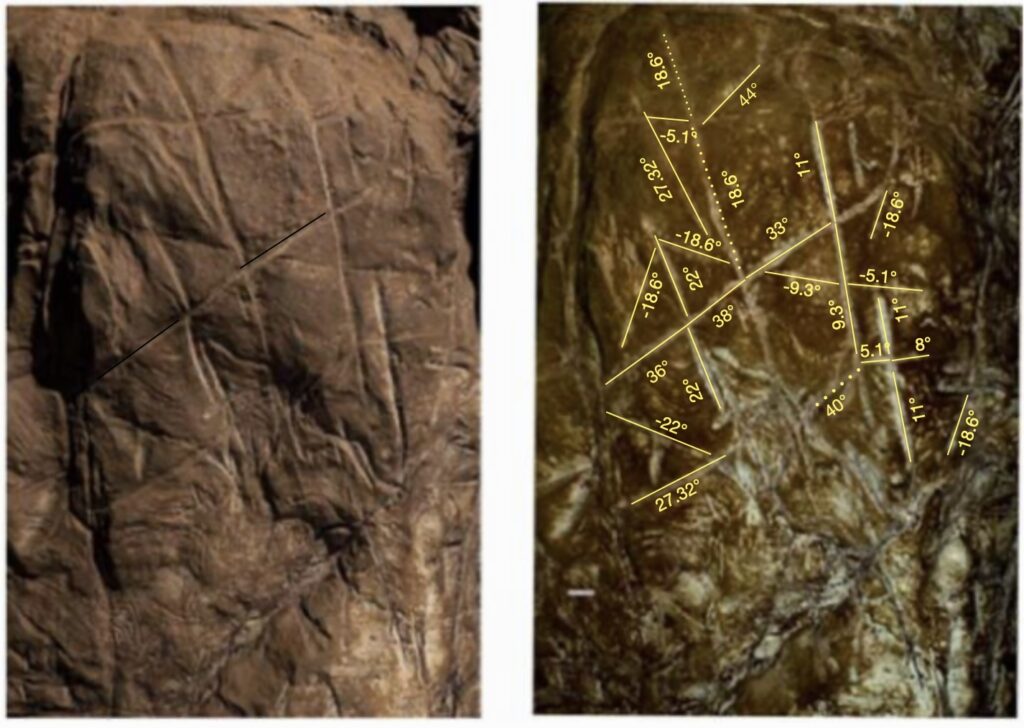Abstract – In this study, a preliminary analysis of the lines present in the Rising Star Cave geometric pattern, which is dated to between 240,000 to 335,000 years old, confirms the lines are consistent with being an early version of an archaic astronomical text.
Author: Derek Cunningham
Introduction
Over the last decade, it has been proposed that the various linear geometric patterns, seen worldwide, might be more than just simple random doodles. In a recent analysis of all the published data from all the world’s oldest geometric images, a statistical study reached beyond 7 sigma confidence levels, and confirmed that most patterns were deliberately aligned to the same set of angular values, and the angles were consistent with an intent to mainly encode two specific astronomical values that are linked to the motion of the moon. These being the 27.32 day cycle that rotates around the location where the moon sets on the horizon each month, and the larger 18.6 year cycle, which is linked to earths 18.6 year eliptical orbital, and thus also overlaps with where the moon sets on the horizon.
Within the archaeological records, there are many early examples, with most of the earliest known geometrics uncovered in Africa, and Europe. These examples typically date to between 100,000 to 200,000 years old. However, in a recent publication, a new much older geometric was uncovered at Rising Star Cave in the Bloubank River valley, which is just outside the Cradle of Humankind World Heritage Site. This new geometric was dated to be between 240,000 to 350,000 years old, and thus rests firmly within the time period when other species of humans were still active.
In this case the date given to the Rising Star Geometric is firm, because the species of humans that occupied Rising Star Cave was Homo Naladi, whose existence was restricted to the Middle Pleistocene (which was 335,000–236,000 years ago). Thus an analysis of the Rising Star Geometric is important, as it not only would confirm that this archaic text was being used in the era when modern Homo sapiens sapiens first appeared, but it would also confirm the author’s prior studies, which have already noted that many early geometrics are found with other ancient species of humans, and thus not restricted just modern humans and Homo Naladi.
Results
Though this study is based on just one image, which was recorded in less than ideal conditions, as the entry to there cave prevents large, precision camera gear to be brought into the cage, an analysis of the angles present in the geometric pattern shows this geometric image is entirely consistent with the proposed link to astronomical values. In more detail, with just a small rotation of the image to allow for the fact that the camera was not held exactly horizontal, most of the carved lines generate lines where the angles (set either to above or below the horizontal, or to the right and left of vertical) are consistent with the sidereal month and the 18.6 year lunar cycle.

Before continuing, it is important to note that it is not claimed that ancient Stone Age humans could create angles with exceptionally high accuracies, and clearly using simple tools it is not possible to generate lines at exactly 27.32 degrees. In this case, as in all previous studies, it is only claimed that these lines were best attempts, and the alignments are close to these values, and in the author’s prior statistical study, an accuracy of plus or minus 0.5 degrees was offered, even though in many early cases the accuracy was often better than 0.3 degrees.
With this in mind, as can be seen, there are 8 lines consistent with the 18.6 year lunar cycle, with six of the lines consistent with the full 18.6 year cycle and two lines are set to circa are 9.3 degrees which overlaps with the 9.3 year half 18.6-year cycle.
However, in contrast to later known examples of this geometric text the half sidereal month is not present, and only two lines are present that match the full 27.32 day cycle. Here, it should be noted that this sidereal month is often linked to the careful observation of time and the location of background stars as the Earth rotates around the sun, but on Earth it is more easier to observe the 27.32 day cycle of the moonset each month. As a further note, the mid-point of this sidereal month cycle, the moon-set will record a line that aligns due east-west, and from that it is then possible to determine an exact alignment that plots due north. No other tools, or complex mathematics is required.
Amongst the other lines present, there is a group that appears to create the standard 11, 22, 33, 44 degree series. This series appears to be based upon the well-known 11 day difference between the lunar and solar year; and is linked to the well-known fact, in astronomy, that every three years, there is a 33 day difference between the lunar and solar years, which then allows astronomers to reset the lunar and solar calendars by the addition of a 33 day month at the end of the third year.
Finally, the line at circa 5 degrees could represent the five visible planets that wander the night sky. However further work is required to confirm that this line does not represent other potential astronomical values.
Conclusions
In this preliminary study, the consistent appearance of lines that are carved to the sidereal month, and the 18.6 year lunar cycle, plus at least one line at circa 5 degrees, creates a pattern that is in perfect agreement with the structure of later geometric patterns. Thus, there appears to be no reason to discount the possibility that this archaic text was created by other species of humans, prior to the appearance of modern Homo sapiens sapiens.
References




